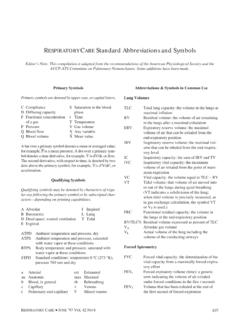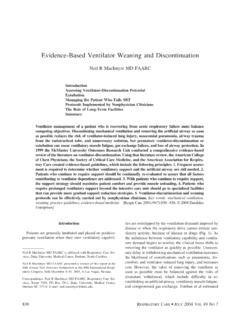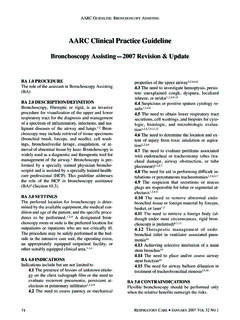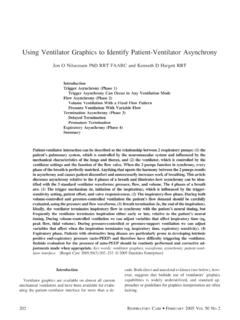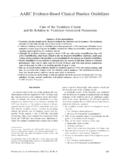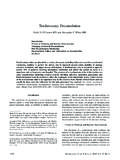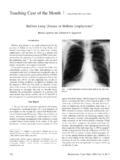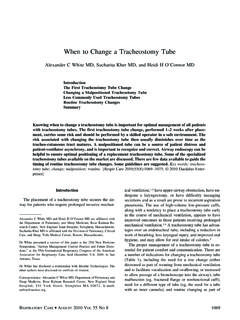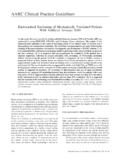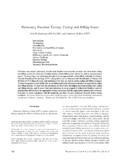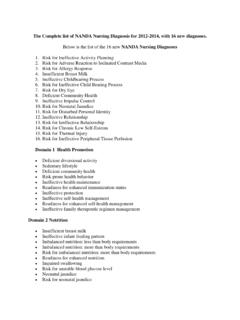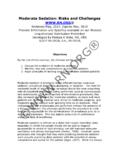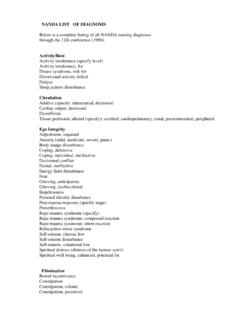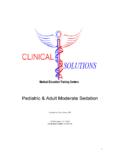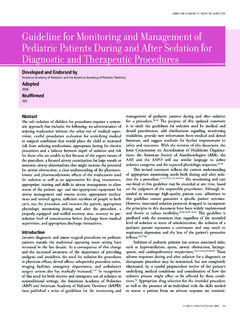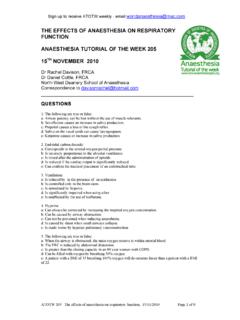Transcription of Tracheostomy and Weaning - Respiratory Care
1 Tracheostomy and WeaningDavid J Pierson MD FAARCI ntroductionWhy a Tracheostomy Might Facilitate WeaningThe Physiologic Impact of a TracheostomyImpact on Dead SpaceImpact on Airway Resistance and Work of BreathingClinical Studies of Tracheostomy and WeaningWhy Good Clinical Studies of Tracheostomy and WeaningAre So Difficult to DoDo Clinicians Manage Intubated Patients and PatientsWith Tracheostomies Differently?SummaryNo hypothesis relating to Respiratory care in the intensive care unit has proved more difficult tostudy in an objective fashion than the commonly held belief that Tracheostomy hastens weaningfrom ventilatory support.
2 Tracheostomy might facilitate Weaning by reducing dead space anddecreasing airway resistance, by improving secretion clearance, by reducing the need for sedation,and by decreasing the risk of aspiration. Available evidence indicates that dead space and airwayresistance are in fact reduced, although whether the magnitude of these reductions explains theclinical observation of more rapid Weaning after tracheotomy is less certain. Most of the data on thissubject come from laboratory experiments and short-term physiologic studies on clinically stablepatients, and the available evidence from clinical trials with Weaning as a primary end point is large multicenter trial showed no advantage to early tracheotomy but demonstrated howdifficult it is to get clinicians to manage their patients with regimens that go against their stronglyheld opinions.
3 The most recent clinical trial found that percutaneous dilational tracheotomy per-formed in the first 2 days in patients projected to need>14 days of ventilatory support greatlyreduced ventilator and intensive care unit days, and decreased both the incidence of pneumonia andoverall mortality, in comparison with Tracheostomy done after day 14. Conducting such trials isdifficult because of investigator and clinician bias, the inability to predict which patients willactually require prolonged mechanical ventilation, and several other factors discussed in this ar-ticle. Tracheotomy probably does aid in liberating some patients from ventilatory support, but thismay be as much from its effect on clinician behavior as from any physiologic words: Tracheostomy , tracheotomy, acute Respiratory failure, mechanical ventilation, Weaning , extubation, work ofbreathing, dead space, complications.
4 [Respir Care 2005;50(4):526 533. 2005 Daedalus Enterprises]David J Pierson MD FAARC is affiliated with the Division of Pulmonaryand Critical Care Medicine, Harborview Medical Center and with theUniversity of Washington, Seattle, J Pierson MD FAARC presented a version of this paper at the 20thAnnual New Horizons Symposium at the 50th International RespiratoryCongress, held December 4 7, 2004, in New Orleans, : David J Pierson MD FAARC, 325 Ninth Avenue, Box359762, Seattle WA 98104. E-mail: APRIL2005 VOL50 NO4 IntroductionClinicians managing patients in both medical and sur-gical intensive care units (ICUs) are familiar with the fol-lowing scenario: A patient, often elderly and with seriousunderlying medical problems, requires intubation for acuterespiratory failure or major surgery, and thereafter remainson the ventilator for many days, despite repeated attemptsat Weaning .
5 A tracheotomy is performed, and within a dayor 2 the patient is off the ventilator and can leave the repeatedly observed this sequence of events, it ishard for clinicians to avoid the general conclusion that, forpatients who require prolonged mechanical ventilation, atracheostomy hastens liberation from ventilatory supportand facilitates transfer out of the article examines the above conclusion from thestandpoints of theoretical rationale, relevant physiology,and clinical evidence. After listing the potential reasonswhy a Tracheostomy might facilitate Weaning , it reviewsthe physiologic concepts involved and the available liter-ature, and discusses possible explanations for the lack ofdefinitive studies on this topic.
6 It deals with tracheostomyas typically performed in ICU patients, and not with thepermanent procedure done in connection with total laryn-gectomy for cancer. Although there is literature on trache-ostomy in infants and children, this article deals primarilywith the management of adult patients. The wordtrache-otomyis used here for the surgical procedure of creatingan opening in the trachea, andtracheostomyfor the open-ing so created, as well as in referring to artificial airwaysinserted into a Tracheostomy Might Facilitate WeaningFor patients requiring prolonged mechanical ventilation,performing a tracheotomy might facilitate Weaning for anumber of reasons (Table 1).
7 Although liberation fromventilatory support may not be possible because of inad-equate ventilatory drive or impaired oxygenation, thesemechanisms can readily be identified and usually do notprevent Weaning in the long-term setting. Most patientswho repeatedly fail attempts at Weaning do so because ofthe inability to keep up with the work load required byunassisted ,2 Such inability arises from exces-sive ventilatory demand, from impairment of the functionof the ventilatory pump, or from a combination of dead space and elevated airway resis-tance can both lead to ventilatory requirements that areexcessive for the patient, and decreasing them by means ofa Tracheostomy might make the difference between venti-lator dependence and successful might facilitate Weaning in less dramaticways.
8 Such as by making it easier to clear airway secre-tions, by thus decreasing the likelihood that the tube willbecome partially obstructed by inspissated mucus, by mak-ing the patient more comfortable (and hence requiring lesssedation), or by reducing the likelihood of aspirationthrough improved glottic function. In some institutions,patients with tracheostomies can be managed on ventila-tors outside the ICU, while those who are endotracheallyintubated cannot. In such settings, Tracheostomy could fa-cilitate Weaning by permitting the patient to be moved toa less intense environment where more gradual withdrawalof ventilatory support could be accomplished.
9 Finally, asdiscussed below, it is possible that clinicians tend to man-age patients with endotracheal tubes (ETTs) and tracheos-tomies differently, and that this could account for the morerapid Weaning often seen with the Physiologic Impact of a TracheostomyBreathing humidified air through a Tracheostomy tubediffers from normal breathing via the intact upper airwayprimarily with respect to the volume of dead space and theimpact of airway resistance. These factors are the usualones cited in explaining why a difficult-to-wean patientmight be able to breathe unassisted through a tracheos-tomy tube but not through a trans-laryngeal ETT or, byinference, following on Dead SpaceMedical students and Respiratory therapists are taughtthat anatomic dead space, contained in the upper airwayand the intrathoracic conducting airways, is about 2 mL/kg, or roughly 150 mL in an average-size in cadavers determined the extrathoracic dead space(not including the trachea and main bronchi)
10 To be approx-imately 75 is clearly more than the volume in atracheostomy tube (Fig. 1, A and B). Davis et al6found astandard 12-cm cuffed Tracheostomy tube with inside di-ameter (ID) mm to have a volume of 5 mL, whereasthat of an ID tube of the same length was 6 15-fold difference in dead space between the 7-mmTable Reasons Why Tracheostomy Might FacilitateWeaningReduced dead spaceLess airway resistanceDecreased work of breathingBetter secretion removal with suctioningLess likelihood of tube obstructionImproved patient comfortLess need for sedationBetter glottic function, with less risk of aspirationAbility to move patient out of the intensive care unitChanges in clinician behaviorTRACHEOSTOMY ANDWEANINGRESPIRATORYCARE APRIL2005 VOL50 NO4527tracheostomy tube and the nonintubated state is reducedslightly by any additional dead space in connecting tubing,T-piece, Tracheostomy collar, or other appliance used toprovide humidified studies on the effects of this difference in deadspace between the nonintubated state and a tracheostomytube are few.
